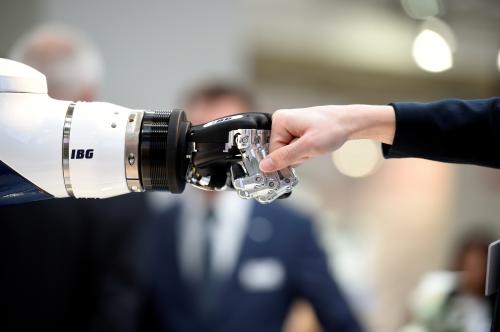Last year, two massive firms, FoxConn and Walmart, announced that they would be replacing 60,000 and 7,000 jobs, respectively, with artificial intelligence (AI)-powered technology. Six months later, Carrier followed, announcing its plans to automate 600 jobs. These structural shifts reflect a growing trend of integrating AI into the workforce. While most technological shifts are assumed to disrupt low-skilled labor markets, the proliferation of AI technology seems more likely to disrupt an unexpected population: skilled knowledge workers whose jobs involve data-driven decision-making.
Grappling with the looming impact of AI’s growing adoption requires that we develop a fundamental understanding of the technology. Artificial intelligence is an umbrella technology of which task robots are just one dimension. In fact, a more significant component of artificial intelligence that impacts our daily lives emanates from sophisticated machine learning algorithms that learn independently and make autonomous decisions. This holistic, constitutive definition of AI technology serves to better inform policymakers on their options than the lay public robot-dominated ideations of AI.
Technological contagion is at full throttle as companies compete in the AI space. The versatile technology is increasingly accessible, largely because of low cost barriers and technical fungibility, to companies of diverse scales; including small businesses, start-ups, and everyday entrepreneurs. Predictably, the spread of artificial intelligence technologies has unsettled some and prompted Luddites to decry automation and fan fears about human replacement in the workplace. This unfortunate fear mongering blurs an important reality: machines create fascinating outputs that require less human energy to produce, and they do so at relatively lower costs.
Machines are unexpectedly disrupting upper-echelon workers
Sophisticated algorithms that learn adaptively at increasing speeds create a new value proposition for companies. They are far cheaper than human workers and significantly reduce cost uncertainty, which makes excellent news for earnings calls. But regrettably, machine integration presents a less than rosy outlook for workers, regardless of skill level.
The integration of machines into the workforce means that income uncertainty is emerging as a concern for a new category of workers—highly skilled knowledge individuals whose jobs involve data-driven decision-making. Dynamic machine algorithms have a distinct data-driven competitive advantage over human pattern detection. For example, dynamic machine algorithms are better equipped to search massive data sets for profitable patterns. Man Group Plc is a multi-billion investment firm, which aggressively experiments with artificial intelligence technology in its fund management business. Since 2014, Man Group’s AI-managed fund has generated consistent profits and now autonomously manages $5.1 billion in assets. Similarly, Entilic, a recent medical start-up, reported that its AI algorithm “outperformed four radiologists in detecting and classifying lung modules as benign or malignant.”
Our public psychology is conditioned to imagine low-skilled workers as the frontline victims of the automation downside. But to maintain this idea is to be misguided about the group of workers who are at the highest risk of marginalization—at least for now. Policymakers must update their perception of who the affected groups are and think beyond the conventional narrative, which holds that automation disproportionally impacts low-skilled workers. This narrative is misleading and may cause us to develop incorrectly specified solutions. The figure below illustrates a simple word-count of low-skilled job descriptions and reveals—unsurprisingly—that these jobs tend to be service-centric, retail-oriented and dependent on personal interactions.
Low-skilled occupation job descriptions

Replacing these service-centric jobs with AI is an expensive proposition and requires scores of experiments to successfully replicate spontaneous human interactions and emotional intelligence—a risky profit gamble. Eatsa, a fully automated restaurant chain, provides critical lessons. The company recently announced its decision to close some locations in response to customers’ general reluctance to substitute emotionless machines for human interaction. Research by McKinsey & Company contextualizes Eatsa’s experience, finding that the degree to which AI is disruptive to an occupation depends on the underlying functional work activities as well as the cost and feasibility of automating the job function.
A growing number of companies have successfully substituted workers with artificial intelligence technology. The important nuance to take note of here is that highly skilled workers were the primary victims of this trend—not low-skilled ones. For example, between 2011 and 2017, Goldman Sachs replaced 600 desk traders in its workforce with 200 coding engineers. And Goldman is not alone. Instead, their shift toward algorithmic-based trading is being replicated at an accelerated pace in the investment banking space—an industry that has historically paid extraordinary wage premiums for trading skills.
Conceptually, it is easier to replace these high-skill workers rather than service workers whose jobs depend on personal interactions. According to Technology Review, Goldman Sachs incubated and fully scaled a small startup experiment in less than a year. The successful trial reduced the unit’s wage cost to zero. In human terms, the machine demonstration permanently displaced workers. Goldman now boasts “the entire consumer lending platform is fully machine operated.”
Cutting labor costs is an instant booster shot to earnings per share valuations. Blackrock Investments recently announced an automation investment, which will replace 13 percent of its portfolio management workforce. If CEOs continue to follow Goldman Sachs CEO Lloyd Blankenfein’s lead in a bid to remain competitive, then a new reality will emerge for high-skilled workers: compressed labor markets that mostly value elite technologists who can design complex tasks for uncomplaining machines to perform.







Commentary
AI should worry skilled knowledge workers too
November 8, 2017